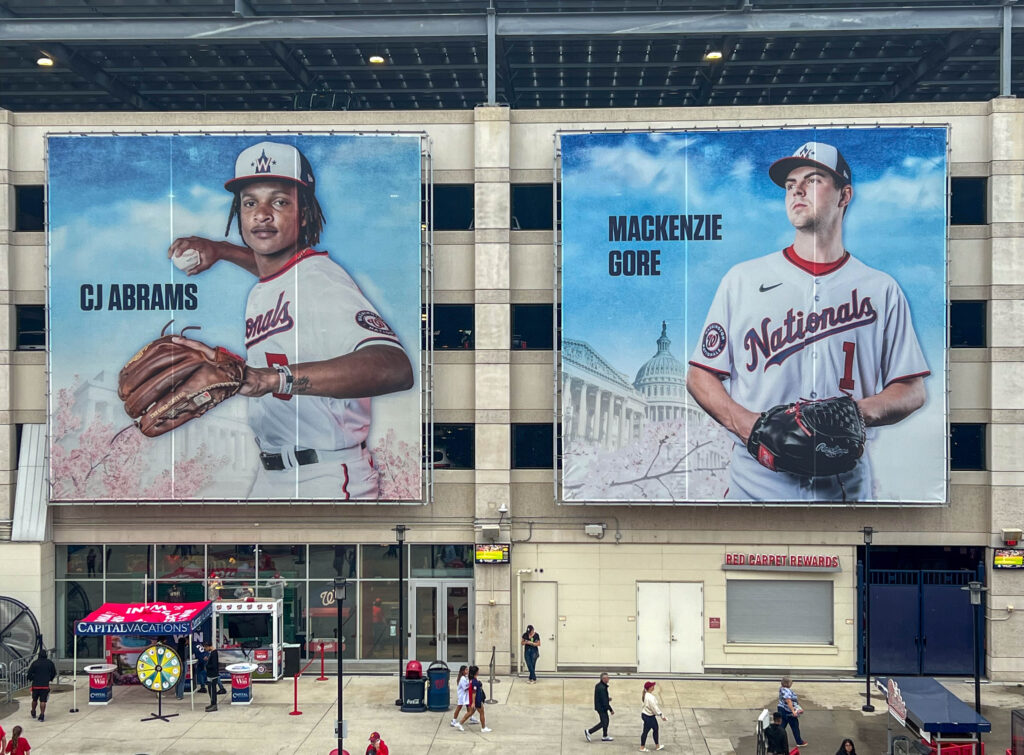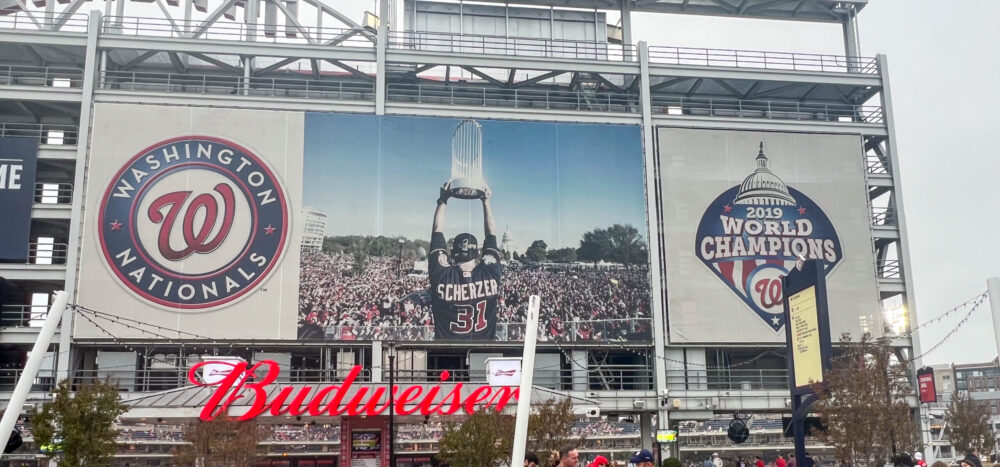WASHINGTON – Jarad Kopf has been a Nationals fan since the team relocated to the nation’s capital in 2005. He attended the team’s second-ever home game and still remembers that John Patterson was the starting pitcher.
Watching the team win the 2019 World Series was the most gratifying moment of his nearly two-decade obsession with the team.
“It was just like this huge monkey was let off the back,” said Kopf, 37, from northern Virginia, who added that he cried immediately after the last strike of the series. “It was a euphoric feeling.”
The 2019 World Series gave Washington its first baseball championship in 95 years. But the post-title drop off has been almost unprecedented.
Capital News Service measured the winning percentage of every World Series champion in the five seasons after winning the title since 1903. The Nationals .407 winning percentage since hoisting the Commissioner’s Trophy is the second-lowest of any World Series champion in the half-decade after winning the title.
The only champion with a worse post-series, five-year slump is the 1913 Philadelphia Athletics, who had a .386 winning percentage from 1914-1918.
Unlike the Nationals, who haven’t been to the playoffs since 2019, the 1913 Athletics made it back to the World Series in 1914. But after being swept by the Boston Braves and facing incredible financial competition from the upstart Federal League, team owner Connie Mack parted ways with a number of star players, including multiple future Hall of Famers.
In 1916, Mack’s team had a .235 winning percentage and were nicknamed “the Pathetics.”
“It’s oddly fitting that they’re right there with the Pathetics,” Kopf said of the Nationals. “I’m almost shocked they weren’t worse.”
The Nationals’ fall was much different from the slide of the Athletics, who won their third World Series in four seasons in 1913. In the Nationals case, there was no new league poaching players and no individual moment of heartbreak that turned the tide of the success.
Instead, a pandemic, injuries, a lack of aggressiveness to acquire proven talent and the wait for young talent to form a new core doomed the post-title Washington club.
“They weren’t doing any of the things that you have to do to become competitive in any kind of short-to-medium-term time frame,” said Michael Baumann, a writer for the baseball statistics and analysis site FanGraphs. “They weren’t drafting particularly well. They weren’t developing particularly well. They weren’t signing free agents.”
The Nationals declined to comment for this story.
The fall off
Baumann called the Nationals 2020 season “the mother of all World Series hangovers.”
Following their title, the Nationals lost star third baseman Anthony Rendon to the Los Angeles Angels. Then, as a result of COVID-19, the season was shortened to just 60 games.
The one positive heading into that shortened season was the team had re-signed World Series MVP Stephen Strasburg to a seven-year, $245 million contract that practically ensured he would spend the rest of his career with the Nationals.
The team went 26-34, a .433 winning percentage, in the pandemic season and finished last in the National League East. Worst of all, Strasburg got hurt in his second start of the year.
Strasburg was the top selection in the 2009 MLB Draft, and his debut in 2010 represented a new hope for a franchise that had yet to experience success. Despite battling injuries, Strasburg had been a three-time All-Star and finished fifth in National League Cy Young voting in 2019.
When he entered free agency after the World Series, Strasburg, much like Rendon, had the option to ditch the Nationals for a bigger market. Instead, he chose to re-sign with Washington.
After his injury in 2020, Strasburg only pitched six more games, making his final appearance in 2022 before officially retiring in April.
“He wanted to be in D.C., which not very many people do,” Kopf said. “He could have left for the Yankees and been a stud in New York and gotten way more money and fame, and he didn't. He wanted to stay here and it was sad to see that (injury).”
The Nationals continued to struggle in 2021 and at the trade deadline, Nationals General Manager Mike Rizzo orchestrated a fire sale. The centerpiece of the six trades Rizzo made was shipping Max Scherzer, a three-time Cy Young Award winner, and 27-year-old shortstop Trea Turner, to the Los Angeles Dodgers. Both were instrumental in the Nationals’ title run.
“You could kind of tell they were running on fumes,” Kopf said of the 2021 team.
The next year brought even more devastating news to Nationals fans: Rizzo traded Juan Soto to the San Diego Padres in August.
Soto was 23 at the time of the trade and already a two-time All-Star.
In return, the Nationals, who also traded first baseman Josh Bell, acquired MacKenzie Gore, a 23-year-old rookie who was among the sport's most promising pitchers, as well as a trio of notable prospects: shortstop CJ Abrams, outfielder James Wood and Robert Hassell III, a first round pick in 2020. Luke Voit, a veteran first baseman/designated hitter and Jarlin Susana, an 18-year-old pitcher, were also in the deal.
“A lot of people at Baseball America who have experienced a lot more trades than me thought about this as one of the most impressive prospect hauls that we'd ever seen for a player,” said Carlos Collazo, who covers the Major League Baseball draft and minor league prospects for Baseball America.

Weeks before the trade, Soto reportedly declined a contract worth 15 years and $440 million from the Nationals. The $29.3 million annual average on that contract would rank 20th all-time today, according to Spotrac.
Soto will be a free agent this offseason and is expected to sign a contract worth at least $500 million, according to ESPN’s Jeff Passan. But, if it were up to Baumann, he’d still be in D.C.
“I would have given him whatever he wanted,” Baumann said. “He is just such a hard player to replace, and particularly at that age.”
In the aftermath of the Soto trade, the Nationals finished 2022 with 55 wins and a .340 winning percentage — the franchise’s lowest since moving to Washington — and last in the NL East for the third consecutive season.
In those seasons the Nationals had a winning percentage of .380, the lowest all time for an MLB team in the three years following a championship.
A lack of spending
In the years leading up to the World Series title, the Nationals were among the league’s biggest spenders, according to Spotrac, a website that tracks professional sports spending and contracts.
In both 2015 and 2018, Washington had the fifth-highest player payroll in the MLB. The following two years, they had the seventh-highest payroll.
After the World Series and the pandemic, there was a shift. The Nationals were shedding contracts via trade but not reinvesting in the team.
The Nationals dipped to 13th in spending in the MLB in 2021 and fell to 25th in 2023 before sitting at 24th this past season.
“I’m surprised they weren’t dead last or second to last,” Kopf said.
A better tomorrow?
After winning the World Series, the Nationals not only did not spend, but also lacked young impact players.
Rizzo tried to fix that with the barrage of trades in 2021, but the team has only seen a marginal payoff. Pitcher Josiah Gray, an All-Star in 2023, and catcher Keibert Ruiz — both acquired from the Dodgers in the Turner and Scherzer trade — have shown glimpses of being great players, but have lacked the consistency to realize their potential.
The Nationals won 71 games and had a .438 winning percentage for the second straight year in 2024, but avoided the NL East’s basement for the first time since winning the World Series. A major reason is the players received from the Soto trade.
Gore has struggled with consistency, but has been incredible in spurts.
Through May, the 25-year-old lefty had a 2.91 ERA before seeing that number skyrocket in June and July. September has been Gore’s best, as he posted a 1.26 ERA in the season’s final month.
Abrams was named an All-Star this season after hitting 15 home runs, stealing 15 bases and accruing an .831 on-base plus slugging percentage in the first half of the season.
The 23-year-old shortstop was significantly less productive in the second half of the season.
Abrams was demoted to the minor leagues on Sept. 21, the day after Cody Delmendo of CHGO, a Chicago centric sports outlet, reported that Abrams was out at a casino all night, returning only hours before the team’s afternoon game against the Chicago Cubs. When asked, Nationals Manager Dave Martinez said Abrams was demoted due to an internal issue and declined to give media more specifics.
Wood could end up being a superstar. A 6-foot-7, 234-pound outfielder with the ability to be among the game’s fastest players is a rarity.
“My oldest daughter already knows who he is and could pick him out of a lineup,” Kopf said.
Wood made his major league debut in July and had a .265 batting average with a .354 on-base percentage, with seven home runs and 41 RBIs in 79 games this season.
In addition to the talent from the Soto trade, Dylan Crews, the No. 2 selection in the 2023 draft, dashed through the minors and made his debut on Aug. 26. He was named the organization’s minor league hitter of the year this year. He hit .270 with six triples, 13 home runs and 68 RBIs across Double and Triple-A before being called up to the majors.
“I think (the Nationals) are one of the more intriguing teams,” Collazo said. “Just given the quantity and quality of young, big-league talent they have that can take steps forward over the next few years.”
Since the elation of 2019, it's been a historically rough go for the Nationals and for fans like Kopf, but after floundering for half a decade, there might be promise for the future.
“There's a number of people to get excited about,” said Kopf, who tracks the progress of most of the team’s top prospects online. “Even beyond, (like) the Wood and the Crews, there's some people in the minors that are going to be good in a few years.”


You must be logged in to post a comment.